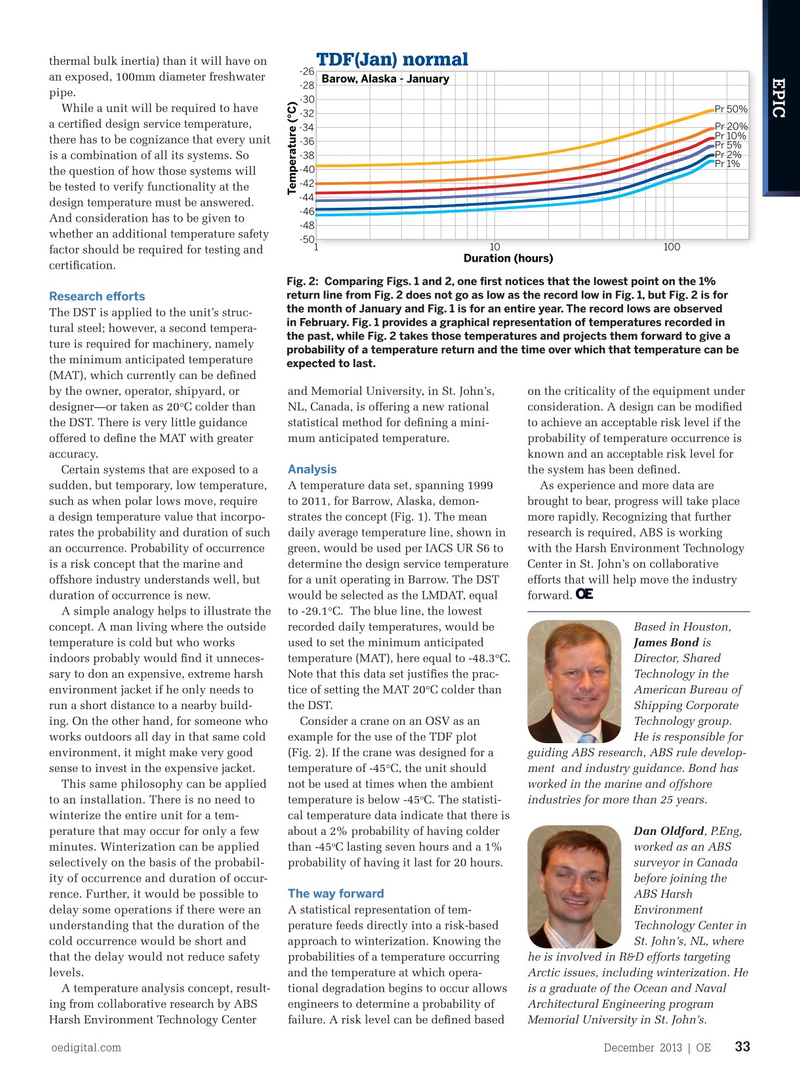
Page 31: of Offshore Engineer Magazine (Dec/Jan 2013)
Read this page in Pdf, Flash or Html5 edition of Dec/Jan 2013 Offshore Engineer Magazine
thermal bulk inertia) than it will have on
TDF(Jan) normal -26
EPIC an exposed, 100mm diameter freshwater
Barow, Alaska - January -28 pipe.
-30
While a unit will be required to have
Pr 50% -32 a certifed design service temperature,
Pr 20% -34
Pr 10% there has to be cognizance that every unit -36
Pr 5% -38 Pr 2% is a combination of all its systems. So
Pr 1% -40 the question of how those systems will -42 be tested to verify functionality at the
Temperature (°C) -44 design temperature must be answered. -46
And consideration has to be given to -48 whether an additional temperature safety -50 1 10 100 factor should be required for testing and
Duration (hours) certifcation.
Fig. 2: Comparing Figs. 1 and 2, one frst notices that the lowest point on the 1% return line from Fig. 2 does not go as low as the record low in Fig. 1, but Fig. 2 is for
Research eforts the month of January and Fig. 1 is for an entire year. The record lows are observed
The DST is applied to the unit’s struc- in February. Fig. 1 provides a graphical representation of temperatures recorded in tural steel; however, a second tempera- the past, while Fig. 2 takes those temperatures and projects them forward to give a ture is required for machinery, namely probability of a temperature return and the time over which that temperature can be the minimum anticipated temperature expected to last.
(MAT), which currently can be defned by the owner, operator, shipyard, or and Memorial University, in St. John’s, on the criticality of the equipment under designer—or taken as 20°C colder than NL, Canada, is offering a new rational consideration. A design can be modifed the DST. There is very little guidance statistical method for defning a mini- to achieve an acceptable risk level if the offered to defne the MAT with greater mum anticipated temperature. probability of temperature occurrence is accuracy. known and an acceptable risk level for
Analysis
Certain systems that are exposed to a the system has been defned.
sudden, but temporary, low temperature, A temperature data set, spanning 1999 As experience and more data are such as when polar lows move, require to 2011, for Barrow, Alaska, demon- brought to bear, progress will take place a design temperature value that incorpo- strates the concept (Fig. 1). The mean more rapidly. Recognizing that further rates the probability and duration of such daily average temperature line, shown in research is required, ABS is working an occurrence. Probability of occurrence green, would be used per IACS UR S6 to with the Harsh Environment Technology is a risk concept that the marine and determine the design service temperature Center in St. John’s on collaborative offshore industry understands well, but for a unit operating in Barrow. The DST efforts that will help move the industry duration of occurrence is new. would be selected as the LMDAT, equal forward.
A simple analogy helps to illustrate the to -29.1°C. The blue line, the lowest concept. A man living where the outside recorded daily temperatures, would be Based in Houston, temperature is cold but who works used to set the minimum anticipated James Bond is indoors probably would fnd it unneces- temperature (MAT), here equal to -48.3°C. Director, Shared sary to don an expensive, extreme harsh Note that this data set justifes the prac- Technology in the environment jacket if he only needs to tice of setting the MAT 20°C colder than American Bureau of run a short distance to a nearby build- the DST. Shipping Corporate ing. On the other hand, for someone who Consider a crane on an OSV as an Technology group. works outdoors all day in that same cold example for the use of the TDF plot He is responsible for environment, it might make very good (Fig. 2). If the crane was designed for a guiding ABS research, ABS rule develop- sense to invest in the expensive jacket. temperature of -45°C, the unit should ment and industry guidance. Bond has
This same philosophy can be applied not be used at times when the ambient worked in the marine and offshore o to an installation. There is no need to temperature is below -45 C. The statisti- industries for more than 25 years. cal temperature data indicate that there is winterize the entire unit for a tem- about a 2% probability of having colder Dan Oldford, P.Eng, perature that may occur for only a few o than -45 C lasting seven hours and a 1% worked as an ABS minutes. Winterization can be applied probability of having it last for 20 hours. surveyor in Canada selectively on the basis of the probabil- before joining the ity of occurrence and duration of occur-
The way forward
ABS Harsh rence. Further, it would be possible to
A statistical representation of tem- Environment delay some operations if there were an perature feeds directly into a risk-based Technology Center in understanding that the duration of the approach to winterization. Knowing the St. John’s, NL, where cold occurrence would be short and probabilities of a temperature occurring he is involved in R&D efforts targeting that the delay would not reduce safety and the temperature at which opera- Arctic issues, including winterization. He levels.
A temperature analysis concept, result- tional degradation begins to occur allows is a graduate of the Ocean and Naval ing from collaborative research by ABS engineers to determine a probability of Architectural Engineering program
Harsh Environment Technology Center failure. A risk level can be defned based Memorial University in St. John’s.
oedigital.com December 2013 | OE 33 032_OE1213_EPIC1_ABS.indd 33 11/22/13 4:13 PM

 30
30

 32
32